2017 MITSUBISHI OUTLANDER engine
[x] Cancel search: enginePage 36 of 521

Front seats
Seat and restraint systems 4-7
4
Operate the switch in the direction of the arrows to raise or
lower the seat.
1- Raise 2- LowerPower seat adjustment
NOTE
To prevent the battery from completely dis- charging, operate the
power seat with the
engine running.
1- Raise or lower the
front end of the seat
2- Raise or lower the back end of the seat
3- Raise or lower the entire seat
BK0239700US.book 7 ページ 2016年6月16日 木曜日 午前10時58分
Page 82 of 521

5
Features and controlsBreak-in recommendations ..............................................................5-3 Keys .................................................................................................5-3 Electronic immobilizer (Anti-theft starting system) ........................5-4Keyless entry system (if so equipped) ..............................................5-7 Free-hand Advanced Security
Transmitter (F.A.S.T.-key)
(if so equipped) ..........................................................................5-13Door locks ......................................................................................5-34 Power door locks ......
...........
...........
...........
...........
...........
.........
.....5-36
Child safety locks for rear door ..........
...........
.........
.........
.........
.....5-37
Liftgate (except for vehi
cles equipped with the
power liftgate) ....5-38
Power liftgate (if so equipped) .......................................................5-39 Inside liftgate release .....................................................................5-46Theft-alarm system ........................................................................5-46 Power window control ...................................................................5-49 Sunroof (if so equipped) .................................................................5-51Parking brake .................................................................................5-53 Steering wheel height and reach adjustment ..................................5-57 Inside rearview mirror ...................................................................5-57Outside rearview mirrors ...............................................................5-60 Ignition switch ...............................................................................5-63 Steering wheel lock (if so equipped) ..............................................5-65Starting the engine .........................................................................5-66 Automatic transaxle (if so equipped)..............................................5-67 Continuously variable transmission
(CVT) (if so equipped)..........5-75
Electronically controlled
4WD system (if so equipped).................5-82
S-AWC (Super-All Wheel Control) (if
so equipped) .....................5-85
4-wheel drive operation .................................................................5-88Inspection and maintenance followi
ng rough road operation ........5-91
Cautions on the handling of 4-wheel dr
ive vehicles ..................... 5-91
Service brake ................................................................................. 5-92 Brake auto hold (if so equipped) .................................................... 5-93Hill start assist (if so equipped) ...................................................... 5-95 Brake assist system ........................................................................ 5-96 Anti-lock braking system .............................................................. 5-97Electric power steering system (EPS) ........................................... 5-99 Active stability control (ASC) ..................................................... 5-100 Cruise control (if so equipped) ..................................................... 5-102Adaptive Cruise Control System (ACC)
(if so equipped) ............ 5-106
Forward Collision Mitigation System
(FCM) (if so equipped) .... 5-117
Ultrasonic misacceleration Mitigati
on System (if so equipped) .. 5-127
Blind Spot Warning (BSW) (wit
h Lane Change Assist) (if so
equipped) .................................................................................. 5-131 Rear Cross Traffic Alert (RCTA) (if so equipped) ....................... 5-136Lane Departure Warning System (LDW
) (if so equipped)........... 5-139
Tire pressure monitoring system ................................................. 5-142 Parking sensors (Front/Rear) (if so equipped).............................. 5-147Rear-view camera (if so equipped)............................................... 5-151 Multi Around Monitor (if so
equipped)..................
...........
........... 5-154
Instrument cluster ........................................................................ 5-163Multi Information display - Type 1 ............................................. 5-164 Multi Information display - Type 2 ............................................. 5-183 Indicator light, warning light, and information screen display list (multi informati
on display - Type 1) .......... 5-191
Indicator and warning light package (multi information display - Type 2) ....................................... 5-214Indicators ..................................................................................... 5-215
BK0239700US.book 1 ページ 2016年6月16日 木曜日 午前10時58分
Page 84 of 521
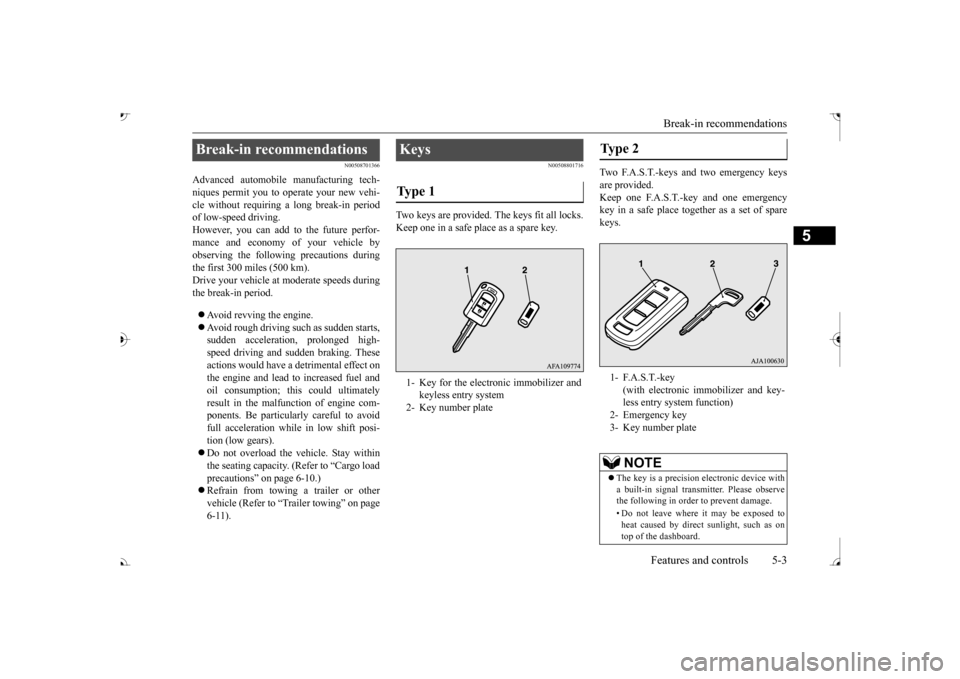
Break-in recommendations
Features and controls 5-3
5
N00508701366
Advanced automobile
manufacturing tech-
niques permit you to operate your new vehi- cle without requiring a long break-in periodof low-speed driving. However, you can add to the future perfor- mance and economy of your vehicle byobserving the following precautions during the first 300 miles (500 km). Drive your vehicle at m
oderate speeds during
the break-in period. Avoid revving the engine. Avoid rough driving such as sudden starts, sudden accelerati
on, prolonged high-
speed driving and sudden braking. These actions would have a detrimental effect onthe engine and lead to increased fuel and oil consumption; th
is could ultimately
result in the malfunction of engine com-ponents. Be particularly careful to avoid full acceleration while in low shift posi- tion (low gears). Do not overload the vehicle. Stay within the seating capacity. (Refer to “Cargo load precautions” on page 6-10.) Refrain from towing a trailer or other vehicle (Refer to “T
railer towing” on page
6-11).
N00508801716
Two keys are provided. The keys fit all locks.Keep one in a safe place as a spare key.
Two F.A.S.T.-keys and two emergency keys are provided. Keep one F.A.S.T.-key and one emergency key in a safe pl
ace together as a set of spare
keys.
Break-in recommendations
Keys Ty p e 1 1- Key for the electronic immobilizer and
keyless entry system
2- Key number plate
Type 2 1- F.A.S.T.-key
(with electronic im
mobilizer and key-
less entry system function)
3- Key number plate
NOTE
The key is a precision
electronic device with
a built-in signal transm
itter. Please observe
the following in order to prevent damage. • Do not leave where it may be exposed to heat caused by direct
sunlight, such as on
top of the dashboard.
BK0239700US.book 3 ページ 2016年6月16日 木曜日 午前10時58分
Page 85 of 521
![MITSUBISHI OUTLANDER 2017 3.G Owners Manual Electronic immobilizer (Anti-theft starting system)
5
N00509101888
[For vehicles equippe
d with the Free-hand
Advanced Security Transmitter (F.A.S.T.-key)] For information on ope
rations for vehicl MITSUBISHI OUTLANDER 2017 3.G Owners Manual Electronic immobilizer (Anti-theft starting system)
5
N00509101888
[For vehicles equippe
d with the Free-hand
Advanced Security Transmitter (F.A.S.T.-key)] For information on ope
rations for vehicl](/manual-img/19/7536/w960_7536-84.png)
Electronic immobilizer (Anti-theft starting system)
5
N00509101888
[For vehicles equippe
d with the Free-hand
Advanced Security Transmitter (F.A.S.T.-key)] For information on ope
rations for vehicles
equipped with the Free-hand Advanced Secu-rity Transmitter (F.A
.S.T.-key), refer to
“Free-hand Advanced
Security Transmitter
(F.A.S.T.-key): Electr
onic immobilizer (Anti-
theft starting system)” on page 5-18.
[Except for vehicles equipped with the Free- hand Advanced Security Transmitter(F.A.S.T.-key)] The electronic immobilize
r is designed to sig-
nificantly reduce the
possibility of vehicle
theft. The purpose of the system is to immo- bilize the vehicle if
an invalid start is
attempted. A valid st
art attempt can only be
achieved (subject to ce
rtain conditions) using
a key “registered” to the immobilizer system. All of the keys provided with your new vehi- cle have been program
med to the vehicle’s
electronics.
• Do not take the remote control transmitter apart. • Do not excessively be
nd the key or subject
it to strong impacts. • Keep the remote control transmitter dry. • Keep away from magnetic objects such as key rings. • Keep away from devi
ces that produce mag-
netism, such as audio systems, computers and televisions. • Keep away from devices that emit strong electromagneti
c waves, such as cellular
phones, wireless devices and high fre-quency equipment (i
ncluding medical
devices). • Do not clean with
ultrasonic cleaners.
• Do not leave the key where it may be exposed to high temperature or high humid- ity.
If you lose your key, to prevent the theft of the vehicle immediatel
y contact an autho-
rized Mitsubishi Motors dealer.If you notify an authorized Mitsubishi Motors dealer of the key number, they can make a new key. The key number is stampedon the key number plate. Keep the key num- ber plate in a safe pl
ace separate from the
key itself.NOTE
No keys other than those registered in advance can be used
to start the engine.
Refer to “Electronic immobilizer (Anti-theftstarting system)” on page 5-4. Refer to “Free-hand
Advanced Security
Transmitter (F.A.S.T.-key): “Electronicimmobilizer (Anti-thef
t starting system)” on
page 5-18. When the theft-alarm is in the system opera- tional status, the alarm operates if a door or liftgate is opened after using the key, thedoor lock knob or the power door lock switch to unlock the vehicle. The system does not enter the preparation status if the keyless entry system or the F.A.S.T.-key operation was not used to lockthe vehicle.
Electronic immobilizer (Anti-theft starting system)
NOTE
NOTE
In the following cases, the vehicle may not be able to recognize
the registered ID code
from the key. This mean
s the engine will not
start even when the key is turned to the “START” position. • When the key contacts a key ring or other metallic or ma
gnetic object
BK0239700US.book 4 ページ 2016年6月16日 木曜日 午前10時58分
Page 86 of 521
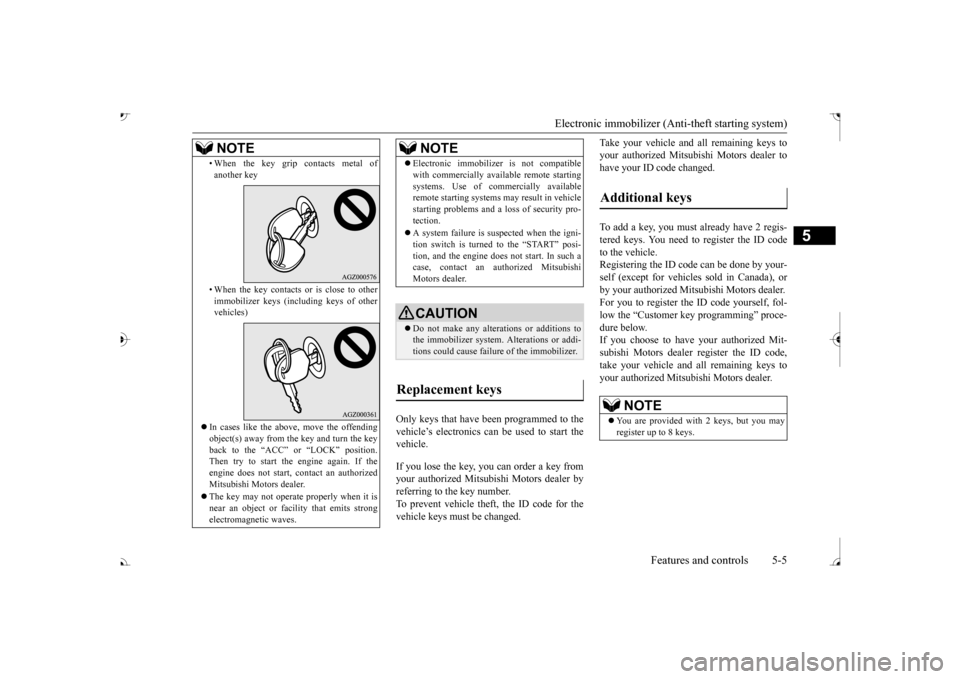
Electronic immobilizer (Ant
i-theft starting system)
Features and controls 5-5
5
Only keys that have been programmed to the vehicle’s electronics can be used to start the vehicle. If you lose the key, you can order a key from your authorized Mitsubi
shi Motors dealer by
referring to the key number. To prevent vehicle theft, the ID code for thevehicle keys must be changed.
Take your vehicle and
all remaining keys to
your authorized Mitsubishi Motors dealer tohave your ID code changed. To add a key, you must already have 2 regis- tered keys. You need to register the ID code to the vehicle. Registering the ID code can be done by your- self (except for vehicles
sold in Canada), or
by your authorized Mitsubishi Motors dealer.For you to register the ID code yourself, fol- low the “Customer key programming” proce- dure below.If you choose to have
your authorized Mit-
subishi Motors dealer register the ID code, take your vehicle and
all remaini
ng keys to
your authorized Mitsubishi Motors dealer.
• When the key grip
contacts metal of
another key • When the key contacts
or is close to other
immobilizer keys (inc
luding keys of other
vehicles)
In cases like the a
bove, move the offending
object(s) away from the key and turn the keyback to the “ACC” or “LOCK” position. Then try to start the engine again. If the engine does not start,
contact an authorized
Mitsubishi Motors dealer. The key may not operate
properly when it is
near an object or faci
lity that emits strong
electromagne
tic waves.
NOTE
Electronic immobilize
r is not compatible
with commercially available remote startingsystems. Use of commercially availableremote starting systems may result in vehicle starting problems
and a loss of security pro-
tection. A system failure is suspected when the igni- tion switch is turned to the “START” posi-tion, and the engine does
not start. In such a
case, contact an au
thorized Mitsubishi
Motors dealer.CAUTION Do not make any altera
tions or additions to
the immobilizer system.
Alterations or addi-
tions could cause failure
of the immobilizer.
Replacement keys
NOTE
Additional keys
NOTE
You are provided with 2 keys, but you may register up to 8 keys.
BK0239700US.book 5 ページ 2016年6月16日 木曜日 午前10時58分
Page 94 of 521
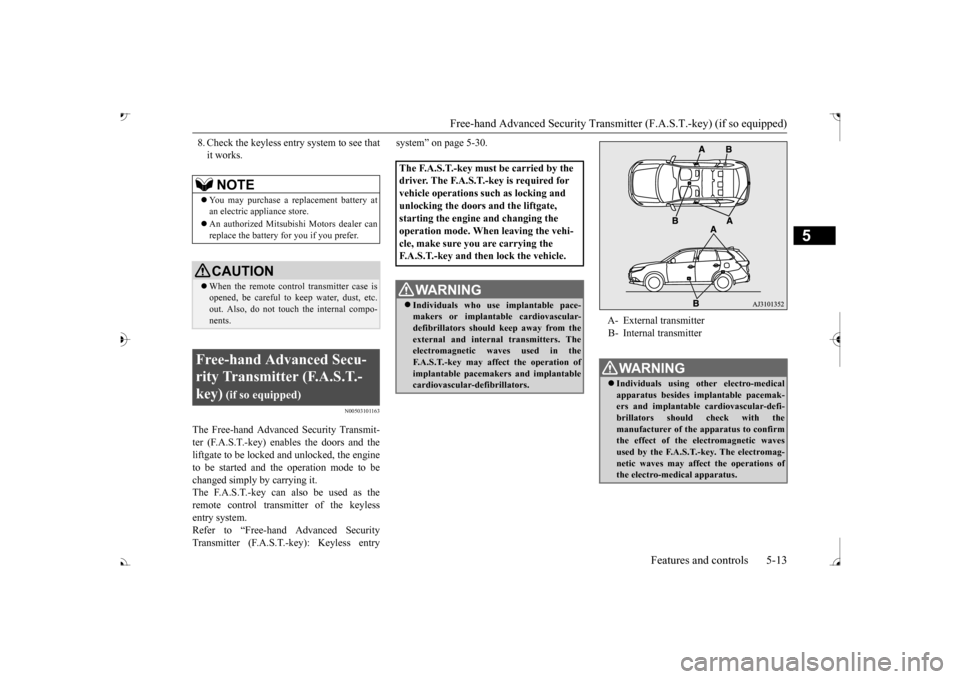
Free-hand Advanced Securi
ty Transmitter (F.A.S.T.-key) (if so equipped)
Features and controls 5-13
5
8. Check the keyless entry system to see that it works.
N00503101163
The Free-hand Advanced Security Transmit-ter (F.A.S.T.-key) enables the doors and theliftgate to be locked
and unlocked, the engine
to be started and the operation mode to be changed simply by carrying it.The F.A.S.T.-key can also be used as the remote control transmitter of the keyless entry system.Refer to “Free-hand
Advanced Security
Transmitter (F.A.S.T.-key): Keyless entry
system” on page 5-30.
NOTE
You may purchase a replacement battery at an electric appliance store. An authorized Mitsubish
i Motors dealer can
replace the battery for you if you prefer.CAUTION When the remote control transmitter case is opened, be careful to keep water, dust, etc. out. Also, do not touch the internal compo-nents.
Free-hand Advanced Secu- rity Transmitter (F.A.S.T.-key)
(if so equipped)
The F.A.S.T.-key must be carried by the driver. The F.A.S.T.-key is required for vehicle operations such as locking and unlocking the doors
and the liftgate,
starting the engine and changing the operation mode. When leaving the vehi- cle, make sure you are carrying the F.A.S.T.-key and then lock the vehicle.
WA R N I N G Individuals who use
implantable pace-
makers or implanta
ble cardiovascular-
defibrillators should keep away from the external and internal
transmitters. The
electromagnetic w
aves used in the
F.A.S.T.-key may affe
ct the operation of
implantable pacemakers and implantablecardiovascular-defibrillators.
A- External transmitter B- Internal transmitterWA R N I N G Individuals using ot
her electro-medical
apparatus besides implantable pacemak- ers and implantable
cardiovascular-defi-
brillators should
check with the
manufacturer of the apparatus to confirm the effect of the el
ectromagnetic waves
used by the F.A.S.T.-key. The electromag-netic waves may affect
the operations of
the electro-medical apparatus.
BK0239700US.book 13 ページ 2016年6月16日 木曜日 午前10時58分
Page 95 of 521
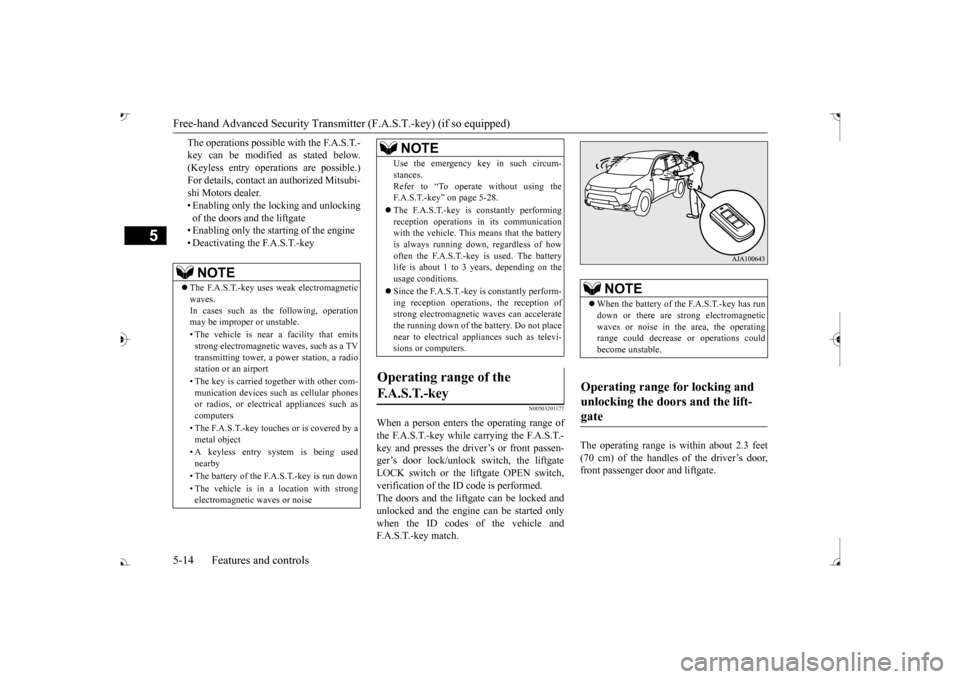
Free-hand Advanced
Security Transmitter (F.A.S
.T.-key) (if so equipped)
5
The operations possible with the F.A.S.T.- key can be modified as stated below.(Keyless entry operations are possible.) For details, contact an
authorized Mitsubi-
shi Motors dealer.• Enabling only the locking and unlocking of the doors and the liftgate • Enabling only the starting of the engine• Deactivating the F.A.S.T.-key
N00503201177
When a person enters the operating range ofthe F.A.S.T.-key while carrying the F.A.S.T.- key and presses the driver’s or front passen- ger’s door lock/unlock switch, the liftgateLOCK switch or the liftgate OPEN switch, verification of the ID
code is performed.
The doors and the liftgate can be locked andunlocked and the engine
can be started only
when the ID codes of the vehicle and F.A.S.T.-key match.
The operating range is
within about 2.3 feet
(70 cm) of the handles of the driver’s door, front passenger door and liftgate.
NOTE
The F.A.S.T.-key uses weak electromagnetic waves.In cases such as the following, operation may be improper or unstable. • The vehicle is near a facility that emits strong electromagnetic
waves, such as a TV
transmitting tower, a pow
er station, a radio
station or an airport • The key is carried together with other com- munication devices such
as cellular phones
or radios, or electrical appliances such as computers • The F.A.S.T.-key touches or is covered by a metal object • A keyless entry system is being used nearby • The battery of the F.A.S.T.-key is run down • The vehicle is in
a location with strong
electromagnetic
waves or noise
Use the emergency key in such circum- stances.Refer to “To operate without using theF.A.S.T.-key” on page 5-28. The F.A.S.T.-key is constantly performing reception operations
in its communication
with the vehicle. This means that the battery is always running down, regardless of howoften the F.A.S.T.-key is used. The battery life is about 1 to 3 years, depending on the usage conditions. Since the F.A.S.T.-key is constantly perform- ing reception operati
ons, the reception of
strong electromagnetic
waves can accelerate
the running down of the ba
ttery. Do not place
near to electrical appliances such as televi-sions or computers.
Operating range of the F. A . S . T. - k e y
NOTE
NOTE
When the battery of the F.A.S.T.-key has run down or there are st
rong electromagnetic
waves or noise in the area, the operating range could decrease
or operations could
become unstable.
Operating range for locking and unlocking the doors and the lift- gate
BK0239700US.book 14 ページ 2016年6月16日 木曜日 午前10時58分
Page 96 of 521
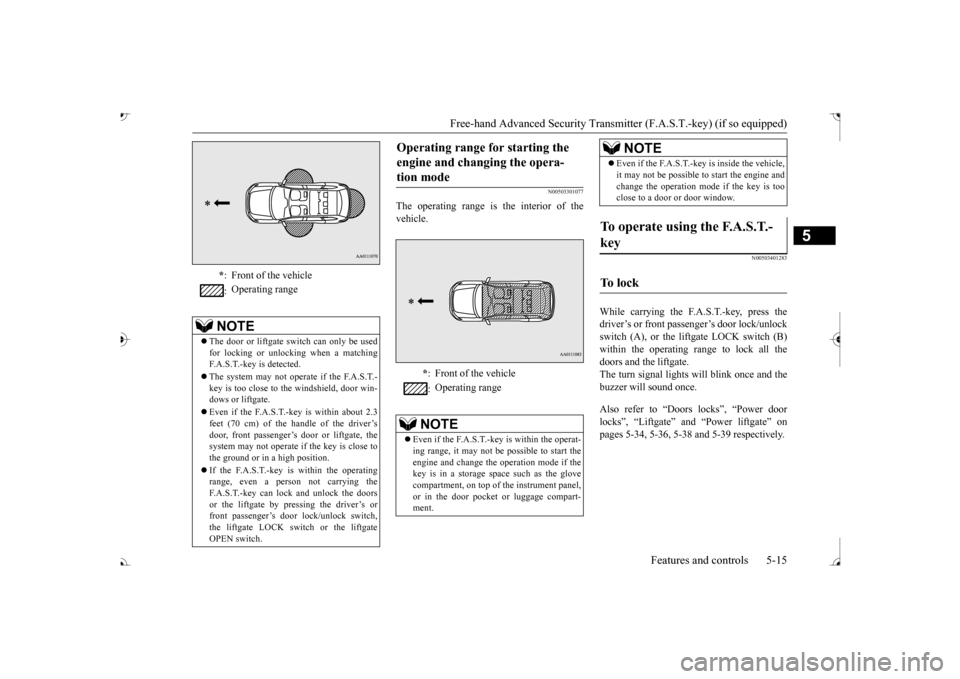
Free-hand Advanced Securi
ty Transmitter (F.A.S.T.-key) (if so equipped)
Features and controls 5-15
5
N00503301077
The operating range is the interior of the vehicle.
N00503401283
While carrying the F.A.S.T.-key, press thedriver’s or front passenger’s door lock/unlock switch (A), or the liftgate LOCK switch (B) within the operating range to lock all thedoors and the liftgate. The turn signal lights will blink once and the buzzer will sound once. Also refer to “Doors locks”, “Power door locks”, “Liftgate” and “Power liftgate” on pages 5-34, 5-36, 5-38 and 5-39 respectively.
* : Front of the vehicle : Operating range
NOTE
The door or liftgate
switch can only be used
for locking or unlocking when a matching F.A.S.T.-key is detected. The system may not operate if the F.A.S.T.- key is too close to th
e windshield, door win-
dows or liftgate. Even if the F.A.S.T.-key is within about 2.3 feet (70 cm) of the handle of the driver’sdoor, front passenger’s door or liftgate, the system may not operate if the key is close to the ground or in a high position. If the F.A.S.T.-key is within the operating range, even a person not carrying theF.A.S.T.-key can lock and unlock the doors or the liftgate by pressing the driver’s or front passenger’s door lock/unlock switch,the liftgate LOCK switch or the liftgate OPEN switch.
Operating range for starting the engine and changing the opera-tion mode
* : Front of the vehicle : Operating range
NOTE
Even if the F.A.S.T.-key is within the operat- ing range, it may not be possible to start theengine and change the
operation mode if the
key is in a storage space such as the glove compartment, on top of the instrument panel,or in the door pocket or luggage compart- ment.
Even if the F.A.S.T.-key is inside the vehicle, it may not be possible to start the engine andchange the operation mode if the key is tooclose to a door or door window.
To operate using the F.A.S.T.- key
To l o c k
NOTE
BK0239700US.book 15 ページ 2016年6月16日 木曜日 午前10時58分